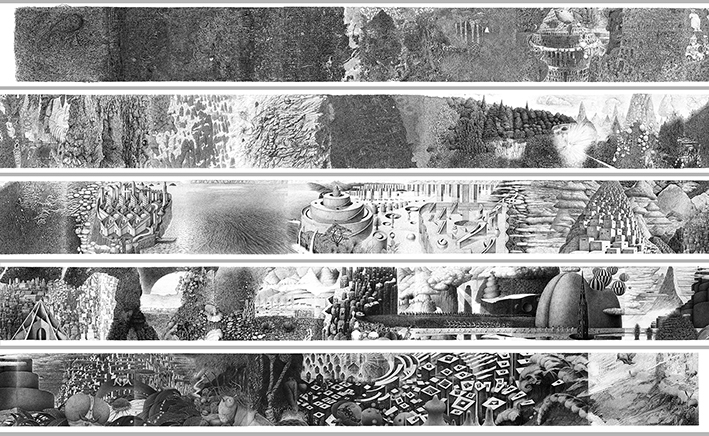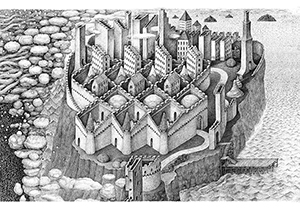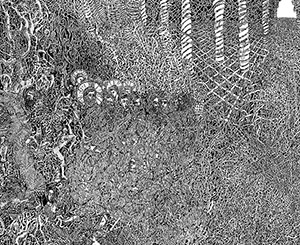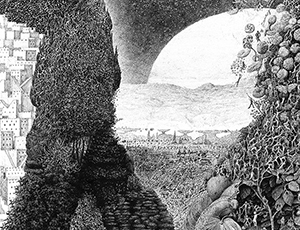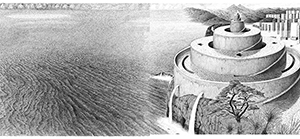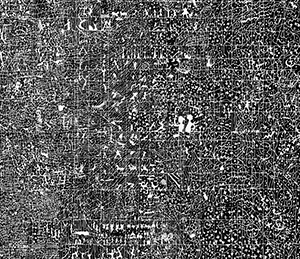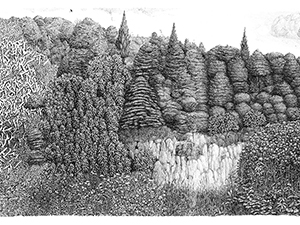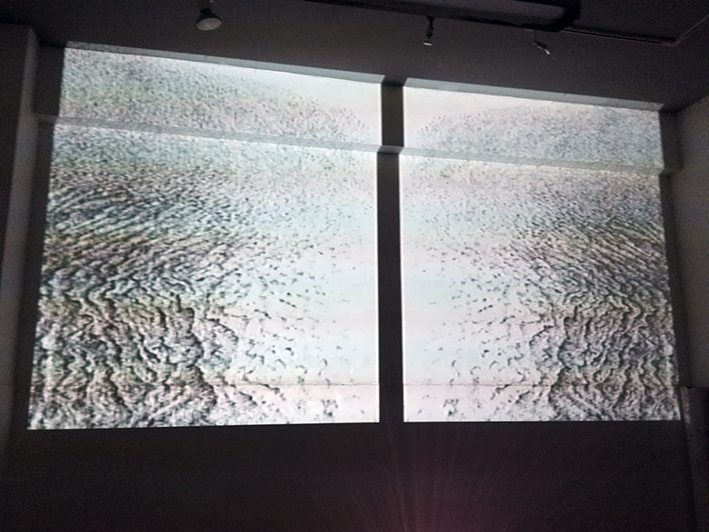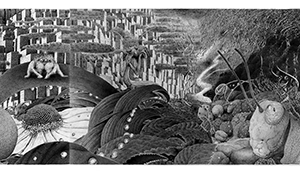Life Scroll, is a highly detailed and sustained drawing in pen on paper which continues as a daily discipline. The drawing started in 1991 and is now 18 meters long. Kentaro Chibafs fluctuations of expression between his late 30s and the present day are evidenced on this scroll. @@@@@@
To release the scroll from linguistic definitions and a narrow range of classification, Chiba has intentionally opted for automatic drawing, creating a space loaded with contradiction; not least, by consciously contrasting Western perspective expression and mirrored projection (using water surfaces), with Eastern contra-perspective, isometric projection methods and the birds-eye view. From the beginning, he has been interested in the idea of the distant view, which can suggest the absence of a viewer or an invisible viewer in the distance. For Chiba, distant and anonymous vision, without evidence of a viewer, suggests a kind of visual purity.
Over 25 yearsf of accumulated daily drawing has made the scroll a more neutral than personal expression. Life Scroll consists of numerous fragments, aspects of the artist, which are transient and ephemeral. On the other hand, Life Scroll can be considered as a stream of consciousness. Chiba believes that a scroll, in terms of format, can mirror the depths of the subconscious (Alaya, in Sanskrit) where the border between individuals and the rules of linguistic division are supposed to vanish. Chiba believes that to emphasize only time passing is wrong. In the scroll, time and space seem to flow but at the same time, to be synchronic as an aggregation of numerous moments. As such, time becomes ambiguous.
Chiba thinks that there are two categories of subconscious expression. The first, is expression achieved in a moment. Examples would include music improvisation, automatism in art, the impromptu, haiku, conversation and so on. The other, is expression formed gradually whose characteristic is collective rather than personal. Symphonies, weaving, carving, sculpture, pointillism, Renga (collaborative poetry), long novels and languages would fit into this category. Life Scroll belongs to this second category. Chiba wishes to make Life Scroll anonymous rather than personal.
Sometimes Chiba finds in the scroll a trace of something that would happen long after a particular section was drawn; but it always appears in hindsight. This section was drawn in 2000, in which waves seem to rise up. The oval building on the shore looks deserted. The area seems like a reservoir but it also looks like a nuclear power plant facing the sea. In 2011 T?hoku earthquake and tsunami threatened Fukushima Daiichi nuclear plant and caused one of the most terrible nuclear disasters ever.
Chiba uses only a precise black pen (0.05mm) to draw the scroll. Sometimes, a strange passion compels him to express images in white negative. So in the scroll there are several areas where figures and patterns are shown in white negative. Logically, there should be no difference in duration between depicting figures in black and in white but expressing images in white with a thin black pen is a longer process and requires higher concentration on the part of the artist. For example, drawing a long thin line in white often takes him a year while drawing a thin line of the same size in black takes only seconds. But this twisted process brings him something important.
In the scroll, Chiba tries to create deep forests, springs and inviting tiny burrows to induce small creatures into the scroll. The scroll suggests narrativity (and so, time) over a long span of years but can also be considered, away from linguistic assertions, a panorama on a distant horizon. Narrative always comes later. Once these small inhabitants settle down in the scroll, it will begin.
Perspective is vision from a particular point. It indicates the physical body of the viewer as the fixed position from which we recognize the mutual relationship between the viewer and objects. On the other hand, from a distant view, it is difficult to recognize where the viewer is standing. A distant view works one-way without sign of the viewerfs existence and awareness of it from an object. Distance provides an anonymous eye, implying a different vision from that of a human being.
The Celtic knot has always fascinated Chiba, as well as the patterns of rattan baskets and laces. The image of intertwined cords has two aspects: the first is the unraveling of entangled threads as the symbol of solving problems, the other is the magical power of the knot that can lure and seize and absorb evil spirits into itself.
A time-lapse animation, consisting of frames from each dayfs drawing, shows how the Life Scroll has progressed over 25 years. In contrast to another animation, Life Scroll Scrolling, this animation represents time as elapsed or diachronic. Edited with its reflected image, the composition of the animation is symmetric and suggests the changing front view from a boat on the river.
eLife Scroll Scrollingf is an animation where the image is magnified and shrinks with the movement of a viewpoint. But from a distance, the whole scroll appears as an extensive scene close to the horizon and may look like a view of the river from its bank. In contrast to eLife Scroll Time-Lapsef, this animation suggests time as diachronic or synchronous.
Artcorp Inc, 84 Orchard Street, NYC 10002, 212 475 0448
https://www.facebook.com/artifactnyc?bookmark_t=page
https://twitter.com/artifact212?lang=en
https://www.instagram.com/artifact212/

